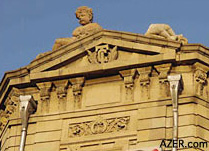|

Autumn
2005 (13.3)
Pages 38-47
Construction!
Destruction?
Blueprint of Baku's Urban Development
by Pirouz Khanlou
See this article in Azeri
  Since
Azerbaijan gained its independence in late 1991, Baku's growth,
as evidenced by the recent building boom, has been phenomenal.
In the past five years, more than 500 new high-rise towers have
"sprung up like mushrooms after rain," as the Azerbaijanis
say. Since
Azerbaijan gained its independence in late 1991, Baku's growth,
as evidenced by the recent building boom, has been phenomenal.
In the past five years, more than 500 new high-rise towers have
"sprung up like mushrooms after rain," as the Azerbaijanis
say.
Unfortunately, Baku's development has been anarchic with no reference
to any comprehensive strategy for urban planning or design, according
to Architect Pirouz Khanlou of Los Angeles, who has carried out
numerous architectural projects in the city.
Photo: Pirouz Khanlou.
Regrettably, the city
is barely able to cope with such accelerated growth. Khanlou
stresses urgency in addressing these issues and insists that
unless serious steps are undertaken, the future spells disaster,
especially given that the city is located in an active earthquake
zone.
As one who has been directly and continuously involved with Azerbaijan
since the first days of its independence in the early 1990s,
Khanlou shares his concern for the city's development and particularly
for the safety of those living there.
Khanlou suggests tackling these problems on both a short-term
and long-term basis. Some issues can be resolved quickly; others
require a major overhaul of the municipal infrastructure. He
urges a broad vision for the city and recommends that the government
employ professionals and experienced consultants to conduct in-depth,
comprehensive studies in search of practical, but reliable solutions.
The consequence of ignoring growth issues, Khanlou argues, is
a guaranteed formula for disaster. Officials and "nouveau
riche" developers can fool themselves as much as they want,
but their negligence in addressing such issues will not change
the bitter truth about Baku's future. One day, sooner or later,
Nature will insist on following its own rules. Today is the moment
to act. Tomorrow may be too late to avoid catastrophe and correct
problems brought on by negligence and incompetence.
It's for this reason that we have undertaken to translate this
lengthy article into Azeri and to publish it alongside the English
version. We believe these issues are critically important for
the welfare of Azerbaijanis and hope that our efforts will lead
to community discussion and tangible results.

Above: Panoramic view of Baku's skyline.
More than 500 towers have been erected in the past five years.
Architecturally, there is no sense of unity and cohesiveness.
Photo: Pirouz Khanlou. October 2005.
Ten years ago on October 28, 1995, fire swept through one of
Baku's evening Metro trains during rush hour, killing more than
300 commuters and injuring another 500.1 It was the worst Metro accident ever
recorded in the history of railway transport-anywhere in the
world.
Shortly afterwards, I challenged Baku's lack of strategy in transportation
planning.2 "The
reality," I wrote, "is that traffic on Baku's streets
is far more congested today [1995] than it was even just three
years ago. In fact, traffic is rapidly turning into a nightmare.
In sections of central Baku, it's faster to go on foot than to
drive. In this period of transition from a socialist to a market
economy, the city will continue to develop in a haphazard way
unless there is a serious strategy that anticipates the future.
Entrepreneur activities will become paralyzed."
Well, a decade has since passed, and the haphazard development
of the city has continued at an even more rapid pace than one
could imagine. Traffic has become a daily nightmare and has,
indeed, brought the city to a halt. Today, traffic jams are the
everyday norm.
Complicating this issue is the fact that there has been a tremendous
boom in construction in Baku, particularly during the past five
years as more than 500 high-rise towers have been erected - not
to mention the thousands of new low-rise buildings. This has
led to an incredible high density of population in the center
of the city.
Nothing is wrong with development, in and of itself. But when
it leads to serious negative consequences related to the safety
and welfare of the people, then the issue of urban development
must to be examined and steps taken to rectify these problems.
Development needs to move forward in a planned, deliberate, systematic
and scientific fashion, not one based on spontaneity or whim.
An Azerbaijani friend of mine - an intelligent, highly educated
and socially conscious fellow - recently broached the subject
with me: "Construction is a sign of progress," he observed.
"I realize that something is wrong, but I don't know exactly
how to pinpoint the issues."
In this article, I attempt to identify some of these problems
and propose some pragmatic solutions - both short term and long
term. This article is written for the general reader - and thus
does not use highly technical architectural and engineering terms.
The most important thing to understand is that Baku is facing
a major crisis, which will have enormous repercussions and consequences
if the City does not move quickly and seriously to address these
issues and resolve them.
The Larger context
The issue of traffic
should be examined within the framework of its much broader urban
context. Traffic congestion is merely a symptom of an "urban
planning disorder". Baku's transportation system was designed
for the Soviet era [1920-1991], and it simply can't keep pace
with the demands of a more open market economy, fueled by the
independent spirit of entrepreneurism. During the Soviet era,
there were relatively few cars in Baku. Archival photographs,
taken as recent as 15 years ago, show fairly empty streets with
few vehicles. The road system seemed fairly adequate with its
fairly wide avenues and boulevards.
Below: Lenin Square - 1968. Postcard.
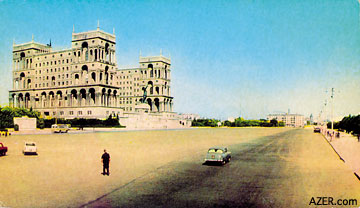  The
use of private cars during the Soviet period was deemed a privilege,
primarily reserved for ranking government officials. Even so,
it wasn't easy to get a car; there were long waiting lists. People
waited for years. In general, the public relied upon mass transportation
- buses, trolleys and the Metro. The
use of private cars during the Soviet period was deemed a privilege,
primarily reserved for ranking government officials. Even so,
it wasn't easy to get a car; there were long waiting lists. People
waited for years. In general, the public relied upon mass transportation
- buses, trolleys and the Metro.
Oil Baron Haji Zeynalabdin Taghiyev (1823-1924) is credited with
being the first person in Azerbaijan to own a car. Soon after
Henry Ford began manufacturing Model T's in the United States
in 1904, he had one shipped to Baku. By 1911, there were 36 automobiles
bumping along the cobble stone streets alongside horses, carriages
and pedestrians.3
The City Plan at the beginning
of the 20th century was quite adequate. By that time, Baku had
become the most sophisticated metropolitan center in the Caucasus.
Based on well-conceived Urban Planning, the municipal infrastructure
included parks, streets and public transportation.
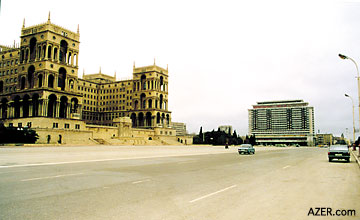  Left: Azadlig (Freedom) Square - 1993. Photo: Pirouz
Khanlou. Left: Azadlig (Freedom) Square - 1993. Photo: Pirouz
Khanlou.
Problems such as securing
a safe water supply, which had plagued the city for nearly half
a century, had finally been resolved. The Shollar Pipeline brought
water from the foothills of the Caucasus, nearly 190 kilometers
away.4
A sewage system was in place, as was a transportation system
that included both rail and trolley. Public buildings had been
constructed, including schools, hospitals, theaters, government
administrative offices, and places of worship (mosques, churches,
a huge cathedral and a synagogue). The crowning jewels to Baku's
architectural landscape were its private residences-elegant,
ornate and often palatial-built by the oil industrialists.5 During the height of the Oil Boom (1880-1920),
Baku witnessed incredible urban development. More than 700 residential
and community buildings were constructed. Both local and European
architects were involved.
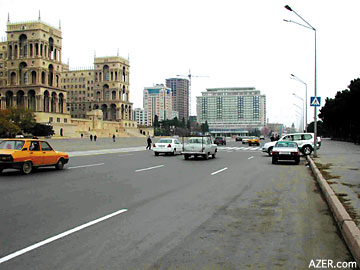  Left: Azadlig (Freedom) Square - 2005. Photo: Elman
Gurbanov. Left: Azadlig (Freedom) Square - 2005. Photo: Elman
Gurbanov.
But these glorious architectural
buildings faced destruction at an alarming rate when the Bolsheviks
seized power in 1920 and confiscated all property. In many cases,
the owners who had not fled the country were killed. Buildings
were subdivided into multiple living units, sometimes housing
as many as 20 to 25 families.
Family accommodations were often
limited to one and two rooms, but the kitchens and bathrooms
had to be shared with other families as communal space. Still
today you can see hundreds of examples where dining rooms with
highly ornate decorative ceilings were literally partitioned
right down the middle of the room with a wall that separated
living space for two different families.
Another neglectful practice of the Soviet period that negatively
impacted the buildings of the Oil Baron period was the failure
to maintain the buildings. Deprived of a sense of ownership,
apartment residents did not feel responsible to take care of
public spaces such as entrances, stairways, courtyards or facades.
As a result, communal spaces often became dilapidated and run
down simply because they "didn't belong to anybody".
No one felt responsible. Buildings collected a century of dirt
and grime, and by the time Azerbaijan gained its independence
70 years later (1991), most buildings were in desperate need
of a facelift, via sandblasting. Exterior facades cried out for
a coat of paint.
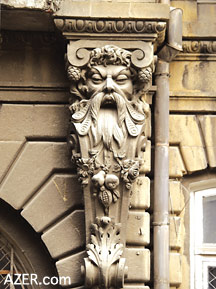  With
today's rise in land value, developers are buying up these old
properties and demolishing them so they can profit on the limited
premium space in downtown. Towers of 15-25 stories are replacing
the old buildings that used to exceed no more than two, three,
or at most, four floors. With
today's rise in land value, developers are buying up these old
properties and demolishing them so they can profit on the limited
premium space in downtown. Towers of 15-25 stories are replacing
the old buildings that used to exceed no more than two, three,
or at most, four floors.
As far as central planning was concerned during the Soviet period,
beginning with Stalin's era (until mid-1950s), the center of
power was transferred to Moscow, as were all decisions related
to its Master Plan.
This period was marked by the New Economic Plan (NEP) in the
Soviet Union and the undertaking of major construction of numerous
public buildings and infrastructure projects.6
Above: Ornate stone carving on the facade
of the Mitronoff Residence built during Baku's Oil Boom at the
beginning of the 20th century. Buildings of that period are often
highly decorative, inside and out. Many such buildings are being
demolished and replaced with skyrise towers. Photo: Betty Blair.
The next major wave of construction (late 1950s to mid-1980s)
is identified with Khrushchev and characterized by large-scale,
massive housing projects, consisting of pre-fabricated, low-quality
concrete buildings, typically nine stories high. Generally, the
same typical floor plans were duplicated throughout the Soviet
Union, without taking into consideration the local context, architecture
or culture.
From the early 1980s until the collapse of the Soviet Union in
late 1991, the Soviet bureaucracy, crippled by an economy that
was nearly bankrupt, proved to be incapable of continuing its
ambitious Socialist city planning and urban development projects.
It could no longer maintain the existing buildings and aging
infrastructure. Some experts suggest that the government's inability
to maintain the infrastructure was one of the contributing factors
that hastened the downfall of the Soviet Union. This collapse
suddenly left 15 independent republics, including Azerbaijan,
to fend for themselves and take on the responsibility of charting
their own destinies.
Baku Today
Obviously, Baku's reality today is quite different from that
of the Soviet period. Market economy and private ownership both
introduce a different complexity. Owning a car is no longer a
luxury. In recent years, an estimated 12 new cars per day have
been added to Baku's streets. Traditionally, it was men who drove.
Today, many women sit behind the wheel.7 A few years ago, it would have been
quite exceptional for a family to own more than one vehicle but
not so today.
Despite the enormous popularity of cars, Baku has not built a
single street, highway, overpass or underpass, or developed any
other means of modern transportation system during the past 15
years. In fact, many of the existing surface modes of road transportation,
such as the electric trains and buses, have been retired. Today,
new asphalt covers the old tracks. With the exception of a limited
Metro system (two lines), there is no standard single transportation
company, which operates what could be called a comprehensive
transportation system that meets up to Western standards. There
are, however, a great number of bus and mini bus services that
operate throughout the city, which are both convenient and operate
frequently. However, this mode of transportation cannot be said
to be efficient or safe.
For example, there are no properly designated bus stops, which
provide benches or seating facilities for passengers who must
wait. There are no timetables, route maps and signage. Instead,
these mini buses operate, more or less, on a spontaneous basis,
picking up passengers and dropping them off seemingly anywhere.
There is no standard ticket system-for example, monthly passes
with discounts for senior citizens, students and the disabled.
Nor are there facilities to accommodate those who are handicapped
to foster independent mobility throughout the city.
Many buses are not well maintained. During morning and evening
rush hours, they tend to be overloaded, creating dangerous conditions
for passengers, as well as other drivers. Accidents occur. Passengers
have even been thrown out of moving vehicles and killed, because
of malfunctioning locks on doors. There have even been occasions
when people were thrown out when the doors were left open for
ventilation.
City Master Plan
These days, no city
can develop successfully without a carefully deliberated City
Master Plan; nor should it be allowed to.
Such plans must be based on
a series of thorough studies in relation to the actual rate of
city growth. The Master Plan should offer solutions for the city's
infrastructure in many spheres, including transportation, communication,
utilities, housing, commercial activities, and public spaces.
The City Master Plan defines Zoning Ordinance requirements for
various types of activities, in relationship to residential,
commercial, public services, and industrial sectors. It determines
and differentiates between the population densities for land
use. It anticipates the complex needs of future growth and development.
It is absolutely mandatory for every modern city to have a Master
Plan as a blueprint for its current as well as future development.
But when you look around Baku and see the chaotic urban development,
it's clear there is no Master Plan.
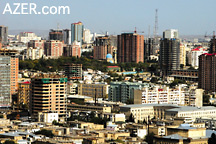  Left: The construction expolsion in downtown Baku creates
extremely high density. Since there has not been adequate Urban
Planning strategy, the infrastructure is vastly overburdened.
October 2005. Photo: Pirouz Khanlou. Left: The construction expolsion in downtown Baku creates
extremely high density. Since there has not been adequate Urban
Planning strategy, the infrastructure is vastly overburdened.
October 2005. Photo: Pirouz Khanlou.
In 1994, a new stage
in the development of the country was ushered in with the signing
of the "Contract of the Century" for the development
of Azerbaijan's largest oil reserves in the Caspian Basin. Western
companies began to establish themselves in the capital, during
the phenomenon that is often referred to as Baku's Second Oil
Boom. But this time, the development has been much more rapid
and on a much grander scale than the First Oil Boom that took
place at the end of the 19th century.
Catapulted by a market economy, major commercial and residential
projects have developed at an extraordinary pace. Construction
and development have been so rapid that existing legislation,
inherited from the Soviet past, has not been able to keep pace.
This is especially true in terms of the municipal administrative
bodies, city ordinances and the establishment of various active
architectural and planning commissions and other crucial public
services governing bodies.
Gas, Power, Water
Shortages
Existing public services and infrastructure, including roads,
electricity network, water and gas supplies, and sewage systems
are loaded far beyond the capacity for which they were designed.
They are now on the brink of collapse. For the past 20 years,
there has not been any major upgrade to these systems. These
new towers place exponential demands on gas, water and power
supplies. Electrical blackouts occur frequently, especially during
winter. The drainage system can't even handle a single heavy
rain without serious flooding in the streets.
There are frequent interruptions to water and gas supplies. Outages
can last for hours, or even days. This is not to say that such
shortages did not exist during the Soviet period. The truth is:
they occurred quite frequently.8 But it is inexcusable that nearly 15
years after independence, these problems have not been solved.
The density of so many high-rise buildings in the center of the
city merely exacerbates these problems.
Department of Building
& Safety
Every modern city needs a Department of Building and Safety (DBS),
which oversees and regulates all construction works. This municipal
body implements all Building Codes (regulations) as well as all
Planning and Zoning Ordinances. It also studies and evaluates
all projects in relationship to the impact they will have on
the environment. Its primary goal is to ensure the safety of
its citizens.
This department provides services such as Plan Checking to ensure
the correct implementation of building regulations and various
city ordinances. It issues Building Permits and evaluates whether
architectural and engineering drawings have been interpreted
correctly via a rigorous inspection system that takes place on
location during every stage of the construction process.
And where does Baku fit into the picture? Baku Municipality has
what they call a Building Department, but there are enormous
shortcomings in the way it functions. Building Codes that exist
are based on old, out-dated Soviet criteria and those are not
even effectively implemented when it comes to new construction.
Baku Municipality does not require an Initial Plan Check process
for architectural and engineering drawings (structural, geological,
electrical, mechanical, fire). In other major cities in the world,
the Plan Check process is a long procedure between the architects
and engineers employed by the owner and those employed by the
city. But in Baku, construction documents are submitted only
for bureaucratic and formality purposes. There is no process
to check every detail suggested by the design to see if it is
in compliance with the relevant National Building Code and various
City Ordinances in order to grant a Building Permit.
Structural calculations are still based on old Soviet standards,
which have not been updated for about 20 years. The last update
took place after the devastating Armenian earthquake in 1988.
Nor do these standards reflect new building technology and materials.
Therefore, every structural engineer is left to reach his own
conclusion for his projects.
Soil and geological tests, which are absolutely essential in
calculating the structural requirements for the buildings foundations
and footings, are rarely conducted. The City might argue that
they do carry out building inspections upon completion of construction.
But evaluating a building at the conclusion of the process does
not enable them to check the functions that are covered in walls,
floors and ceilings. How can the City really judge whether all
structural, electrical, mechanical and plumbing features meet
Code requirements if they are not inspected when they can be
visibly studied. Building inspection should take place frequently
during each of the many stages of construction to ensure that
all stipulations and the building codes have been strictly followed.
Inspections should be carried out at each stage of construction;
otherwise, the durability and safety of buildings is seriously
under question.
Another difficulty arises because many of the contractors who
carry out most of building projects in Baku do not have an adequate
knowledge of high standard building technology. Often there is
serious lack of proper supervision on construction jobs to ensure
good workmanship, especially given that many of the workers are
inexperienced and have not been properly trained. The consequence
is sloppy construction. It becomes evident the moment one steps
inside some of these apartments. Walls are crooked; floors are
not level. Some people are even beginning to crack jokes about
Italy's Leaning Tower of Pisa.
Below: The World Global Seismic Hazard Map
is a triumph of science, as the whole world has been mapped in
terms of its earthquake hazard. The resulting map is the Global
Seismic Hazard Assessment Project (GSHAP) to which 500 scientists
contributed over a period of seven years. Map: UN Hazard Assessment
Program. Courtesy: Andrew Alden at: geology.about.com.

Earthquakes
Earthquakes are one of the most serious threats to construction
in Baku. The entire region is situated in an active seismic zone.
This becomes extremely problematic, given that many of Baku's
high-rises have been erected with shoddy workmanship using substandard,
low quality materials.
Baku's most recent earthquake occurred in November 2000.9
Two strong tremors followed one after another. According to the
U.S. Geological Survey (USGS), the foreshock measured 5.9 on
the Richter scale and was followed minutes later by a massive
quake registering 6.3. Such a force is equivalent to an explosion
of 30,000 tons of dynamite or a 30-kiloton nuclear bomb. The
epicenter of the quake, fortunately, was not on land, but rather
offshore in the Caspian Sea 100 km (62 miles) northeast of the
capital.
As could be expected, deaths resulted - at least 35. The majority
of victims lost their lives from falling masonry and rubble.
Gas explosions killed some people. A few died of heart attacks.
In reality, Baku was rather fortunate, given that so much of
the construction throughout the city is based upon masonry. However,
one must keep in mind that in the year 2000 very few towers had
been erected and the epicenter was a considerable distance from
the capital, deep within the sea. Baku was lucky this time but
who can be sure that nature won't be much more cruel the next
time around?
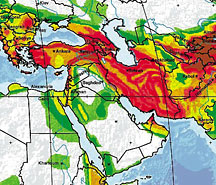  Left: This map insert shows that Azerbaijan and neighboring
countries, such as Iran, Turkey, Armenia and Georgia, are situated
in one of the most seismically active zones in the world according
to the World Global Seismic Hazard Map organized by the United
Nations. Left: This map insert shows that Azerbaijan and neighboring
countries, such as Iran, Turkey, Armenia and Georgia, are situated
in one of the most seismically active zones in the world according
to the World Global Seismic Hazard Map organized by the United
Nations.
It's not just Azerbaijan that
is prone to earthquakes. The entire region is subject to seismic
activity. In 1988, neighboring Armenia experienced a devastating
6.9 earthquake in Spitak, a city north of Yerevan.
The entire population of the city-25,000 people-is said to have
lost their lives. The scale of the destruction was blamed on
substandard infrastructure, prompting Soviet authorities to forbid
any future buildings to be constructed higher than five stories.
In August 1999, Istanbul was hit with an earthquake of 7.4 magnitude.
The Turkish President deemed it the worst natural disaster in
Turkish history. Official Turkish government statistics list
17,127 deaths, 43,953 injuries and an estimated 250,000 residents
who lost their homes. Poor workmanship was faulted as well as
lack of quality control in the use of structural materials-problems,
which could have been avoided if the buildings had been carefully
inspected during the construction process.
In December 2003, an earthquake of 6.6 magnitude flattened the
city of Bam, Iran. An estimated 43,000 people were killed and
20,000 injured. More than 60,000 residents were left homeless.
Essentially the city was wiped out. Mud brick was the primary
building material-the most susceptible of all in earthquakes.
While this article was being written, yet an even more ruinous
quake took place in the Kashmir region between Pakistan and India
in October 2005, claiming at least 75,000 lives, and displacing
an estimated 3 million people. Again, the devastation could be
traced to masonry construction.
These examples, describing how fatal and devastating earthquakes
have been in the region, illustrate how imperative it is for
authorities to address these issues. To ignore these problems
imperils the lives of those who make Baku their home.
Concrete in Construction
The use of mud brick and masonry in construction is categorically
the No. 1 Killer during earthquakes. However, faulty concrete
construction follows close behind.
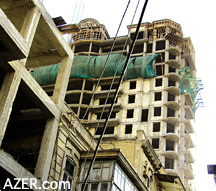  Left: Heavy limestone blocks are commonly used as construction
material in Baku as a substitute for lighter weight bricks or
blocks (see blocks in the wall partitions in the high rise).
The use of limestone blocks is extremely dangerous under seismic
conditions. The abrupt lateral force of an earthquake will cause
any wall without steel rebar reinforcement to collapse. This
is the most common cause of death in earthquake zones. Photo: Betty Blair. Left: Heavy limestone blocks are commonly used as construction
material in Baku as a substitute for lighter weight bricks or
blocks (see blocks in the wall partitions in the high rise).
The use of limestone blocks is extremely dangerous under seismic
conditions. The abrupt lateral force of an earthquake will cause
any wall without steel rebar reinforcement to collapse. This
is the most common cause of death in earthquake zones. Photo: Betty Blair.
Being relatively cheap, concrete is naturally very popular
in areas that don't have access to forests, timber or other industrial
building materials. It is the primary means of construction for
high rises in Baku. During the preparation of concrete, there
are several practices that must be carried out very carefully
so as not to undermine the strength of concrete and make buildings
especially vulnerable to earthquakes. Unfortunately, Baku builders
are often negligent with these tasks.
Failure to "Cure"
Concrete
Concrete must be poured when climatic conditions are neither
too hot, too cold, too dry or too windy. Any of these conditions
will cause the concrete to crack. In Baku the greatest concern
is heat and wind. In such conditions, extreme care must be taken
to cover the concrete to keep it moist and allow it to dry slowly
- a process known as "curing". In hot weather - above
30C (86F) - or during high winds and low humidity, concrete can
dry out easily. Particular care needs to be taken during the
curing process.
This past summer, for example, temperatures often exceeded 40C
(104 F). Yet many workers at construction sites kept on pouring
concrete without curing it, and then they moved right on to the
next level of construction before the lower level had a chance
to dry adequately. Concrete must be cured properly in order to
increase its strength, durability, water tightness, and resistance
to wear.
Diluting Concrete
With Water
The strength of concrete is determined by its ratio of sand,
cement and aggregate to water. This becomes a critical issue
in Baku when concrete must be pumped to the higher floors. Many
contractors unscrupulously cut costs by diluting the concrete
with additional water to make it thinner which makes it easier
to pump to the higher elevations. Additional pumps should be
used to provide the power to lift the heavy cement.
Unfortunately, diluting the concrete causes the segregation of
its components and severely compromises the strength of the concrete-a
guarantee for disaster in earthquake regions.
Vibration Process
The correct use of vibrators is necessary in order to eliminate
air pockets that may occur in the process of mixing concrete;
otherwise, air pockets will remain in the construction of concrete
beams, columns and slabs exposing the steel rebars. Again, this
process weakens the concrete.
Failing to Test
Concrete
During the construction process, it is necessary to constantly
monitor the strength of concrete. Concrete cubes should be made
from the same ready - mixed concrete that is being used in the
building. A test, known as "crash testing", is carried
out in a laboratory to determine strength of the concrete. Unfortunately,
many construction sites in Baku do not conduct such tests and,
therefore, do not actually know the quality and strength of the
concrete they are using. Since there is no official National
Azerbaijani Standardization entity to determine the basic standards
for the quality of construction materials such as cement and
steel, low quality sub-standard grades and even defective materials
are being dumped on the market in Azerbaijan. Some of these products
are being manufactured within the country, others are imported.
Garadagh Cement, a Swiss-Azerbaijani joint venture, is extremely
concerned about the quality of cement being used in construction
throughout the country. At a press conference on October 4, 2005,
Chairman of the Board Uve Kohler warned about serious problems
in the building sector in Azerbaijan and predicted that most
of newly constructed buildings would collapse in an earthquake-even
of weak magnitude.
While Kohler vouched for the integrity of the Garadagh cement,
he claimed that 50,000 tons of defective cement are being sold
and used in construction in Azerbaijan on an annual basis.
Soil and Geological
Reports
In earthquake prone regions, soil and geological reports must
be conducted and seriously studied prior to doing any structural
design and calculations. This is critically important in the
preparation of the foundations and footings in buildings. Problems
occur when soils of certain consistencies "liquefy"
when the ground shakes, causing buildings to collapse - especially
those with small footprints. Unfortunately, many developers do
not bother to carry out soil and geological testing. Again, this
is a recipe for disaster.
Not only are towers at risk, many of the older buildings that
stand within their shadows, would be in jeopardy should any high
rise building collapse above them. Although these lower buildings
may have survived during moderate earthquakes in the past, today
they may be at risk, not through any negligence of their own.
Landslides
Some areas in Baku - especially near the coast - do not have
stable soil and geological conditions, making them prone to landslides.
This is another reason why scientific analysis should be mandatory
prior to any construction. There have been several recent devastating
landslides that resulted in widespread destruction and even death.
In the spring of 2000, a vast expanse of hillside in the south
of the city, above the highway leading out of the city towards
the Bayil district gave way to a massive land slide. More than
70 houses and shops were completely destroyed.
Another serious settlement took place in 2004 as a result of
faulty engineering of a high-rise project under construction.
Wide cracks suddenly appeared in the asphalt in the road north
of the Cabinet of Ministers. Developers had not properly built
a retaining wall. Residents from nearby apartments had to be
evacuated and the avenue was closed for six months. This resulted
in the closure of one of the main thoroughfares between the north
and south ends of the city and further congested traffic in other
parts of the city.
 |
Above: November 2000. Consequences of earthquake
in Baku, which registered 5.9 on the Richter Scale. Multi-storied
building on Azerbaijan Avenue accross from the Museum Center
collapsed. Masonry is the most hazardous construction technique
in seismic conditions. Photo: Arzu Aghayeva.
Above: During the earthquake, one of the Twins
on the pediment of a building
dating back to Oil Baron times in the Pasaj fell to the street
below. Photos: Betty Blair.
Safety Glass
Glass is one of the most prominent features of these high-rise
towers. However, even in a mild earthquake, glass could instantly
shatter, flying through the air-like thousands of daggers. Residents
inside the apartments would be at risk, as would those living
in adjacent low-rise buildings and pedestrians and passengers
in cars in the streets below.
Tempered (toughened) glass drastically reduces such risk. When
tempered glass breaks (and it certainly could even in an quake
of low magnitude), it shatters into many small, cube-like pieces
that are relatively harmless.
Another type of safety glass, known as laminated glass, has a
transparent plastic sheeting sandwiched inside the glass. This
prevents the glass from shattering and flying out. Unfortunately,
it is extremely rare for contractors in Baku to use any of these
types of manufactured safety glass in construction.
Fires
In many parts of the world, the greatest damage from earthquakes
comes from fires caused by gas explosions when gas mains or pipes
break. California Building Code addresses this issue by requiring
every building, old or new, to be equipped with automatic shut-off
gas valves. This simple and relatively cheap device (less than
$50) can prevent catastrophic fires and loss of life. Such basic
equipment is not even known in Azerbaijan!
But if a fire were to break out in most of these towers, few
of them are equipped to handle them. Most towers do not meet
Western Standard Fire Codes. Many lack standard code fire alarm
systems and don't offer sufficient fire emergency escape routes.
Few have back-up, battery-operated emergency lighting to indicate
where the exits are should the electricity suddenly be cut off.
Few buildings have been constructed using fire-rated materials
of low combustibility, which retard the spread of fire. In addition,
many buildings have used electrical systems manufactured from
substandard cheap materials, which have no certified code approval
from any recognized standard authority. Therefore, their safety
value is not known and may not be reliable.
Then there is the question of the capability of the city even
to fight fires successfully. When fires break out, traffic is
likely to impede emergency vehicles from arriving at the scene
of the fire in those first critical moments. In 1996, the British
government donated fire-fighting equipment to Azerbaijan-80 Green
Goddesses 10 (as the green fire trucks are called
in the UK). These vehicles provided twice the pumping capacity
of any fire equipment that existed in Azerbaijan at the time.
Intensive courses were provided so that Azerbaijani firefighters
could train on the new equipment. But the current status of maintenance
and training is not known. In addition, there were no high-rise
towers in Baku a decade ago and so the question remains whether
the existing fire fighting equipment could extinguish a fire
that breaks out on the top floors of these 15-25 story buildings.
Short-Term
Solutions
The problems related to construction and development in Baku
are so complex that they cannot be resolved quickly. It will
take years of hard work and determination to rectify these problems.
However, the current situation cannot be ignored. It is so critical
and so dangerous that it requires immediate attention.
The best strategy would be to identify both short-term as well
long-term solutions. Temporary stopgap measures would give the
city a chance to "buy some time" during the transitional
period to more permanent fundamental solutions. Here are a few
preliminary steps that could be implemented quickly without considerable
investment of time or money. Even these small steps could profoundly
impact the city in a significant way.
1. Halt Construction
projects
The first major step - fundamental to all decisions - would be
to immediately freeze all construction projects on a temporary
basis. No Building Permits should be issued at this time. Such
a decision might seem radical, but it would be the best way to
seriously begin to address construction issues to minimize future
catastrophes and loss of life.
2. Conservation
and Restoration Commission
Baku desperately needs an active Commission for the Conservation
and Restoration of the Architectural Heritage of the city. Some
might argue that such a commission already exists, but if it
were truly functioning as it should, the demolition of these
100-year-old, well designed, well constructed buildings of irreplaceable
charm that date back to the Oil Baron period (1880-1920) would
not be taking place. It's quite tragic that there are no ordinances
to protect these buildings from the sledgehammer and wrecking
ball. And thus, we are eyewitnesses to the deplorable loss of
some of the finest architectural examples that Baku will ever
know. In reality, the cityscape that defined central Baku as
Baku for the past century is fast disappearing.
Such a commission should study each building of that era, as
well as those few that still exist from earlier periods, and
commit to their conservation and restoration. Some of Europe's
major cities, which survived the extensive carpet bombing of
Europe during World War II-Prague, Budapest and Vienna - have
grappled with such issues, and have adopted ordinances that forbid
the destruction of buildings of specific historical periods.
If Baku does not act quickly, the unique legacy of the city's
architectural heritage will exist only as a stack of old faded
photos stashed away in a drawer of an aging historian. It would
be such an enormous aesthetic loss to the city-the tragic consequence
of unwise decisions in an era, marked primarily by greed.
3. Create Responsible
Commissions
An independent Architectural and Engineering Commission should
be created, which would provide the ultimate authority to oversee
all building practices and have both legal and executive power
to recommend and implement the following changes:
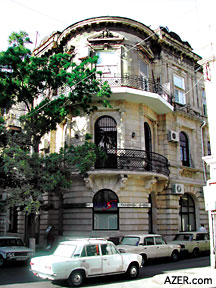 
Left: Fortunately, some of Baku's early 20th
century residential buildings are being restored. A Comission
of the Preservation and Restoration of Baku's Architerctural
Heritage should be established that actively functions to preserve
these fine buildings. Photo: Betty Blair.
4. Building Codes
The process of writing comprehensive National Building Codes
specific to Azerbaijan would be a very involved and complex process.
In the mean time, a stopgap measure could be to temporarily adopt
Building Codes that have been implemented in other seismic-prone
locations, such as Los Angeles, San Francisco, Tokyo or Mexico
City.
5. Assess All Towers
Evaluation should be made of all multi-story structures that
have been built in last decade. Engineering inspections and tests
should be made to ascertain if the buildings are in compliance
with the newly adapted Building Codes in terms of both architectural
and structural design. Highest priority should be placed on determining
whether the buildings conform to structural integrity in relationship
to Baku's seismic conditions.
Buildings that are not found to be in compliance should be evaluated
as to whether they can be upgraded or retrofitted to make them
safe. Buildings that are determined to be unsafe and which cannot
be salvaged should be condemned. A compensation package should
be worked out between the City municipality and the owners. Negligence
and irresponsibility on the part of both city and developer should
be taken into consideration.
6. Fire Compliance
Compliance for fire and electro-mechanical systems, especially
emergency fire exits, fire alarm systems and safe electrical
systems should be required. Buildings which do not meet these
standards should be retrofitted accordingly.
7. Safety glass
Very few towers have installed safety glass-either tempered or
laminated-in their windows. This safety feature is absolutely
crucial to reduce risk of broken glass. Since replacing all the
glass in a building would be very costly, an effective compromise
would be to apply a self-adhesive transparent safety film to
all existing glass. Lamination of safety film prevents glass
from shattering when it breaks and can save lives. In future
buildings, the Building Code should mandate that tempered or
laminated glass be used.
8. Parking
Parking requirements for each building should be established
per unit. For example, in the U.S., the Building Code stipulates
two parking spaces for each apartment. In Azerbaijan, minimally
one parking space should be designated for each unit. To date,
the majority of new residential towers do not allocate sufficient
parking. Some totally ignore the issue and have not provided
any parking spaces at all. Others provide a few spaces and sell
them to owners at premium costs of $15,000 to $30,000 per parking
space. Buildings should be required to resolve this problem by
exploring the possibility of creating surface parking spaces
on their sites or converting some of their lower floors to parking
levels.
9. Traffic
In regard to Baku's congested traffic, a comprehensive Transportation
and Traffic Engineering Feasibility Study should be carried out,
not on its own, but in conjunction with a City Master Planning
and an Infrastructure Development Plan.
In the meantime, some temporary solutions could be implemented
to ease traffic bottlenecks. Many rules governing current traffic
pattern flow are left over from the bygone Soviet era.
  Left: Traffic jams are part of the chaos, which occurs
all day long in Baku, whether it is rush hour, or not. Busy streets
mean more dangerous situation for pedestrians, more dirt, higher
levels of air pollution, as well as excessive noise that comes
from frustrated rivers impatiently honking their horns. This
photo shows typical chaotic traffic on Istiglaliyyat (Independence)
Avenue in front of Baku Sovet (City Hall). Photo: Alakbar Aghasiyev. Left: Traffic jams are part of the chaos, which occurs
all day long in Baku, whether it is rush hour, or not. Busy streets
mean more dangerous situation for pedestrians, more dirt, higher
levels of air pollution, as well as excessive noise that comes
from frustrated rivers impatiently honking their horns. This
photo shows typical chaotic traffic on Istiglaliyyat (Independence)
Avenue in front of Baku Sovet (City Hall). Photo: Alakbar Aghasiyev.
The reality of a market economy makes them outmoded, obsolete
and extremely impractical. For example, traffic rules forbid
"left hand turns" and "'u' turns". Coupled
with the fact that many streets are designated for "one-way"
traffic, drivers often have to drive far out of their way to
reach their destination.
This leads to redundant traffic movement. It wastes valuable
time, consumes excessive fuel which is expensive, and leads to
unnecessary traffic snarls-all of which further pollute the environment.
Traffic flow should be studied. More flexible and practical traffic
patterns should be implemented to alleviate these situations.
Traffic patterns should also be identified during peak periods,
both on a daily basis as well as on weekends. Plans should be
tailored to alleviate problem areas. For example, in Los Angeles,
traffic police have recently been assigned to busy street intersections
during rush hour to facilitate traffic flow. The mere physical
presence of an authority directing traffic at those busy locations
helps to speed up traffic, alleviate blocked intersections and
other difficulties. In some cities, car lanes are reversed during
heavy traffic periods to provide additional flow of traffic in
a specific direction as needed.
10. Street Parking
One of the primary causes of the city's congestion is the manner
in which drivers park their cars. Vehicles are parked anywhere
and in any direction: they're parked double and even triple,
perpendicular or at angles to the curb, and even facing the opposite
direction on one-way streets. These practices are viewed as the
norm since no planned or regulated street parking exists.
Parking spaces should be designated properly and the road painted
to help drivers become more compliant to standard, predictable
parking. In the city center and commercial areas, parking meters
should be installed. Presently, Baku has no parking meters at
all. Meters could provide a steady source of revenue for the
city and could help regulate parking and facilitate traffic flow.
11. Retraining
Traffic Police
Traffic police should be trained to take an active role in helping
alleviate congestion and in facilitating the flow of traffic.
It's not uncommon for police to turn a blind eye to drivers going
the wrong direction on one-way streets or when they double or
triple park. These infringements are accepted as the norm, rather
than as serious aberrations to the obstruction of public space
and traffic flow.
Training should emphasize how to increase traffic flow and ease
the situation brought on by Baku's crowded streets. It often
turns out that the traffic police themselves are the cause of
traffic jams because of the way they mishandle the traffic situation,
adding more anarchy to confused situations.
12. Construction
Sites
Construction sites should
not be permitted to invade half of the street, setting up construction
fences that protrude half way out into on-coming lanes of traffic.
Currently, this is accepted as normal even though the duration
of construction may last for several years.
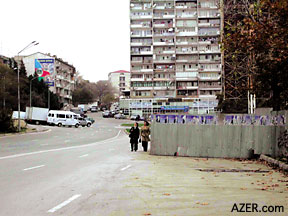  Left: A frequent practice in Baku is to build a fence
around the construction site that protrudes far out into the
street. This obstructs public space and creates enormous traffic
congestion. Techniques and methods exist for handling tight urban
sites which do not intrude into public space but yet ensure the
safety of pedestrians and the flow of traffic. Photo: Elman Gurbanov. Left: A frequent practice in Baku is to build a fence
around the construction site that protrudes far out into the
street. This obstructs public space and creates enormous traffic
congestion. Techniques and methods exist for handling tight urban
sites which do not intrude into public space but yet ensure the
safety of pedestrians and the flow of traffic. Photo: Elman Gurbanov.
13. Good Traffic Signage
Clearly designated traffic signs that are based on standard international
traffic symbols and standard international sizes should be erected
in places that offer high visibility. Drivers should be informed
well enough in advance so that they can respond quickly and appropriately
to important regulations such as "One Way", "Stop",
"Yield", "Do Not Enter", etc.
14. Intersections
One of the major causes of traffic jams occurs when cars get
stuck in intersections. Many countries forbid cars from entering
street intersections unless the driver can successfully pass
through to the other side. In the UK, this is known as the "Yellow
Box Rule" because yellow lines are painted in the forbidden
intersection area. Drivers are ticketed if they break this rule
should they get stuck when the light turns red, as this interferes
with the normal traffic flow from the intersecting street.
15. Retirement
of Cars
Many major cities throughout the world insist on a retirement
program for old vehicles. This helps to regulate the number of
cars on the highway. Such a plan should be explored in Azerbaijan.
A systematic car retirement program not only would eliminate
old worn-out cars but it would help to reduce traffic congestion
and cut down on pollution.
16. Funeral Tents
Funeral tents that are erected in the middle of streets also
cause serious traffic problems. Roads that are accessible in
the morning are often blocked in the afternoon. Terrible traffic
jams result.
Funeral tents provide a venue for friends and family members
to gather and share their grief and condolences.
The tradition is very valuable in society. Such activities would
normally be held inside homes if they were large enough to accommodate
all the guests.
  Left: Funeral tents that are erected in the middle
of strees also cause serious traffic problems. Photo: Elman Gurbanov. Left: Funeral tents that are erected in the middle
of strees also cause serious traffic problems. Photo: Elman Gurbanov.
But the time has come to examine whether the tents that are erected
at the doorstep of residential buildings every time a resident
dies is the most effective way to carry on this tradition.
There are several reasons why alternatives should be sought.
First of all, there have been several occasions when speeding
cars have accidentally driven into the tents and injured and
even killed people.
Secondly, with so many towers being erected in the center of
the city, the population is more highly concentrated. Proportionately
there will be more deaths occurring per square mile. It will
become very impractical always to erect tents whenever someone
dies.
Just as weddings are now organized in specifically designated
restaurants, perhaps the time has come to explore the possibility
of certain halls being used on the occasion of funerals. Funeral
tents obstruct public space and should no longer be permitted.
17. Public Service
Messages
The media could provide an incredibly effective tool for educating
the general population. Public service messages should be created
and presented on TV, radio and newspapers to emphasize safe driving
practices such as the use of safety straps, the importance of
not blocking intersections, consequences of double parking, hazards
of changing lanes without indicating with blinkers, the importance
of crossing the street only at intersections, the necessity of
pulling over to the side of the road and stopping to let emergency
vehicles pass, etc. The widespread repetition of public announcements
would go a long way to educate the general public, raise safety
standards and facilitate traffic flow.
Long-Term
Solutions
After short-gap measures are put in place, more thorough studies
should be carried out and fundamental long-term plans should
be implemented.
Fundamental reforms and changes are needed to Azerbaijan's municipality
to make it an effective governing body. Presently, the mayoral
position is an appointed post and there is no Advisory City Council
to support the immense job of governing the city. No doubt these
are national political issues that must be decided on a governmental
level. Establishing a system of accountability of officials is
critical to the efficient administration of any city.
Departments in the mayor's office relate to architecture, planning,
engineering, public works and building construction. However,
the guidelines under which they work continue to be based on
outmoded Soviet models and Soviet styles of management. Baku
needs modern, well-trained managers, administrators, engineers
and architects to lead the city. It is a well-known fact that
corruption runs rampant throughout all levels of City management.
Such a situation precludes the ability of the City to function
with integrity and leaves the entire population exposed and at
enormous risk because safeguards in the building process have
not been followed. The following suggestions could lead to strengthening
these governmental entities.
1. Building and
Safety Department (B&SD)
The current crisis within the City provides ample proof that
Baku's Building and Safety Department does not function well.
No city can develop unless such responsibilities are assigned
to an integral part of the governing infrastructure and are strictly
adhered to and followed.
It is the Building and Safety Department, which must take on
the responsibility of issuing Building Permits and in providing
controls, related to the safety and compliance of all construction.
It is their responsibility to enforce building regulations through
a system of Plan Checks and Inspections at every major step of
the construction process.
In essence, such a vital department does not exist in Baku today.
A Building and Safety Department should be created that truly
functions in this capacity. The key to its success would be in
hiring recently trained technical staff, who are both knowledgeable
and conscientious. Perhaps their training could take place in
one of the major cities such as Los Angeles or San Francisco,
which deals with seismic conditions similar to Baku's. Such possibilities
should be explored.
2. Master Plan
Baku needs a modern Master Plan like every other well-functioning
cosmopolitan center. The Master Plan should be designed to provide
guidelines and a working basis for the city's present requirements,
as well as its future needs and development. During this past
decade, Baku's existing Master Plan has neither been adhered
to, nor has it been updated to reflect the reality of an independent
nation based on an entrepreneurial market economy.
Construction and development activities that are currently being
implemented have not followed the existing Master Plan. For example,
even public parks and open public spaces are being privatized
and built up by private developers! Zoning Ordinances have completely
been ignored which regulate and deal with issues such as urban
densities, building heights, and the land use of residential,
commercial, public buildings, industrial areas, parks and green
zones.
A carefully thought-out Master Plan would provide direction so
that the city could make critical decisions that benefit the
population as a whole. The most efficient way to create a Master
Plan would be to create a commission, comprised of expert consultants
in Architecture and Planning Engineering from the private international
sector. Such professionals should be chosen who could bring considerable
experience and expertise to this complex task.
Model cities should be studied. For example, the city of Dubai
(United Arab Emirates) is an excellent example of how a rather
simple, small city has been transformed into an incredibly sophisticated
and dynamic international cosmopolitan within less than 30 years.
China is another example of a country, which is undergoing major
urban development and is in the process of total transformation.
In the process, China has hired some of the world's top experts
in the fields of architecture, planning and engineering.
3. Building Codes
(Regulations)
Azerbaijan desperately needs to adapt modern National Building
Codes, which would satisfy contemporary needs. A commission consisting
of well-trained and experienced architects, planners and engineers
should be created and new Azerbaijani Building Codes should be
formulated.
In this regard, it's not necessary for Azerbaijan to "reinvent
the wheel". Azerbaijan can draw upon the global achievements
in architecture, planning, engineering, as well as the building
and construction industry. Building Codes could be studied and
evaluated that have been successfully implemented in other exemplary
modern cities throughout the world, especially those which mirror
seismic conditions similar to Azerbaijan's.
For example, the California chapter of Uniform Building Code
(UBC) could provide a basic model since it already addresses
serious seismic conditions. Then these regulations could be modified
to take into account specific variances and differences in Azerbaijan,
which relate to architectural style, culture, climatic and environmental
factors.
4. National Standardization
There is an urgent need to establish a National Institute of
Standardization in Azerbaijan. Such an institute would be responsible
for the regulation of every product that is marketed in the country,
whether it be produced locally or imported from abroad. Every
product would require the Institute's certificate ascertaining
that it had met the required criteria for quality and safety.
Building materials such as cement, steel and glass would need
licensed approval from this Institute.
This nationally recognized agency would test all products in
its departmental labs in every field from pharmaceuticals to
building materials and electrical appliances to ensure that each
product fulfilled its stated function and met safety requirements.
Such an authority would seek to prevent unsafe, substandard goods
from being dumped on the market in Azerbaijan.
5. Aesthetics
Many of the newly designed buildings lack from good architectural
design, especially in terms of the massing (forms and proportions)
of buildings. In addition, there are situations when the design
bears no relationship to its cultural or architectural context.
Buildings are often finished with cheap, low quality materials
such as stucco claddings painted in a range of bizarre colors.
This results in a strange cluster of eclectic buildings, which
offer no sense of unity and cohesion in relationship to their
context. Given Baku's rich architectural heritage, this is extremely
unfortunate and disappointing.
An effective, well qualified Architectural and Planning Commission
could help to remedy this problem and raise the level of aesthetics
in building design throughout the city. Such a commission would
have the responsibility of approving each project at the initial
stage of every project, and of organizing public hearings to
which the community would be invited. This commission could even
draw attention to some of the existing towers and recommend re-design
or "face lifts" for those, which have become an embarrassment
to the city's appearance.
Sometimes major visual improvements can be achieved with minimal
changes and expense. For example, merely repainting the facade
or re-applying higher quality cladding materials can often transform
a bad design into one that is acceptable.
6. Parking
Baku's traffic problem will never be completely resolved until
parking requirements for new buildings are enforced. Building
Codes should stipulate the minimum parking requirement that each
building must provide.
For example, in the US, the Uniform Building Code (UBC) requires
two covered parking spaces per single-family dwelling.
The same requirement is applicable for multi-unit apartments.
Additional parking is also calculated for Visitor and Handicapped
Parking. Generally, office buildings require three parking spaces
per 100 square meters, and three to five spaces are mandatory
per 100 square meters of retail commercial buildings.
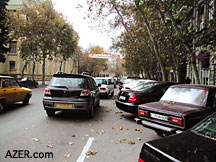  But
this does not solve the parking dilemma for hundreds of buildings
that have already been erected, whose developers did not provide
parking for their residents and clients. For these situations,
the city should construct public parking structures in the city
center, funded by those building towers, which did not make adequate
plans for parking. Residents could rent long-term, permanent
parking spaces and thus provide additional revenue for administering
the city. But
this does not solve the parking dilemma for hundreds of buildings
that have already been erected, whose developers did not provide
parking for their residents and clients. For these situations,
the city should construct public parking structures in the city
center, funded by those building towers, which did not make adequate
plans for parking. Residents could rent long-term, permanent
parking spaces and thus provide additional revenue for administering
the city.
Left: Parking - double, triple, angular,
irregular or "anyway you can" - is one of the primary
causes of traffic jams in Baku. Such parking is so commonly an
accepted practice that it even goes unntoiced and unticketed
by the traffic police. The Baku Municipality has not yet designated
parking spaces on the streets or introduced parking meters -
both of which would help establish some order to this chaotic
situation. Photo: Elman Gurbanov.
Once sufficient public parking spaces were provided throughout
the city, designating "Restrictive or Limited Drive Zones"
in the city center or applying "Congestion Fees" for
private cars could also alleviate heavy traffic in the center
of town.
Such cities as London and New York have recently implemented
these practices and begun charging tolls when cars are driven
into certain districts of the city. Cities are discovering that,
indeed, such practices really do cut down on the complications
brought on by ever-worsening traffic and pollution. There are
many advantages: traffic is reduced, speed is increased, noise
level is decreased and pollution reduced. At the same time, funds
are raised to help sustain the administration for the city.
7. Traffic Feasibility
Studies
A comprehensive Transportation and Traffic Engineering Feasibility
Study should be conducted. A traffic engineering consultant company
with broad international experience and expertise should be hired
to tackle such a large-scale project.
The study should seek to find solutions to facilitate the flow
of traffic, recommend efficient methods of connecting various
districts of city, propose various modes of connectivity via
highways, freeways, connector bridges, underpasses and overpasses.
Also it should explore the possibility of building inner or outer
Ring Roads around the city.
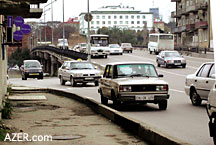  Left: Bakikhanov Bridge near the Hyatt Hote passes
over Tbilisi Avenue. Photo: Elman Gurbanov Left: Bakikhanov Bridge near the Hyatt Hote passes
over Tbilisi Avenue. Photo: Elman Gurbanov
Ring Roads are deliberately designed to bypass city centers.
They detour vehicular traffic so that it doesn't have to go through
the city center to reach its destination. Historically, this
is still an opportune time for the Azerbaijani government to
undertake the construction of Ring Roads, as much of the land
still belongs to the government from the Soviet period and has
not yet been privatized.
Baku has three distinct city
districts that have been built in concentric rings from the center.
The inner core consists of the Old City (Ichari Shahar), dating
back to medieval times.
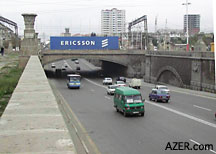  The
second ring was developed during the Oil Boom period (European
architecture of the late 19th and early 20th century). The third,
or outer ring consists of those parts of the city that were developed
during the Soviet period. Generally called "micro regions",
they consist primarily of massive housing projects. The
second ring was developed during the Oil Boom period (European
architecture of the late 19th and early 20th century). The third,
or outer ring consists of those parts of the city that were developed
during the Soviet period. Generally called "micro regions",
they consist primarily of massive housing projects.
Left: Baghirov Railway Bridge (underpass)
on Heydar Aliyev Avenue (formerly Moscow Avenue) on the route
toward the airport. This underpass was built in 1953 because
Mir Jafar Baghirov, First Secretary of Communist Party and Stalin's
right-hand man in Azerbaijan, got stuck waiting for a train to
pass while he was rushing to the airport. Baku has fewer than
half a dozen overpasses and underpasses. Bridges are essential
for facilitating traffic flow. Photo: Elman Gurbanov.
These Ring Roads could first be built in the micro regions. The
first Ring Road could connect the district of Ahmadli in the
east to Micro Region No. 9 in the
west. These Ring Roads could be freeways with limited entrances
and exits so traffic could move quickly. In the future, another
Ring Road might be considered even further out on the periphery.
The feasibility study should also evaluate existing public transportation
systems and recommend new means of transportation according to
both the city's present as well as its future needs.
Conclusion
Growth and development are inevitable and denote progress, but
they need to be regulated and structured, following a careful
scientific approach, which is governed by rules of urban planning
and design. Baku has a unique history. The discovery of oil transformed
the sleepy little mid-19th century town into a sophisticated
cosmopolitan center within less than 40 years (1880-1918). Early
industrialists and authorities had the wisdom and vision to understand
the limitations of their technological competence. That's why
they invited experts-some of the best architects and engineers
that Europe could offer - to help them develop a sophisticated
and elegant city, and to seek solutions to the problems that
they didn't have experience and know how to handle themselves.
Unfortunately, today's reality is quite different. The new Oil
Boomers have not followed the judicious path of their ancestors.
The present state of affairs bears witness to their negligence.
It's easy to point fingers, placing blame on the present-day
municipal leaders, but this will not resolve the issues that
Baku faces today. Practical and constructive solutions must be
found. A serious disaster in a country as small and fragile as
Azerbaijan could bring the country to a halt, resulting in incalculable
loss and suffering and making recovery virtually impossible.
Officials and "nouveau riche" developers of this country
can fool themselves as much as they want. But their negligence
in addressing such issues will not change the bitter truth about
Baku's future. One should not be blind to the fact that one day,
sooner or later, Nature will insist on abiding by its own rules.
Tomorrow may be too late to correct today's mistakes and negligence
and avoid catastrophe.
Pirouz Khanlou is a practicing architect based in Los Angeles
who has carried several very successful architectural projects
in Baku.
Search at AZER.com
Footnotes
1. "The Terrifying Escape: Eye
Witness Accounts of Baku's Metro Accident" by Chris Cannon.
AI 3.4 (Winter 1995).
2. "Baku's
Metro Accident: A Challenge to Strategize" by Pirouz
Khanlou and Elisabeth Atwell. AI 3.4 (Winter 1995).
3. "The
First Car in Baku" by Manaf Suleymanov. AI 7.3 (Autumn
1999).
4. "Water:
Not a Drop to Drink. How Baku Got Its Water. The British
Link-William H. Lindley" by Dr. Ryszard Zelichowski. AI
10.2 (Summer 2002).
Also: "Building
Infrastructure: Taghiyev's Commitment to the Water Problem"
by Manaf Suleymanov. AI 10.2 (Summer 2002).
"Baku's
Search for Water: A Brief Chronology" by Mammad Mammadov.
AI 10.2 (Summer 2002).
5. "Architecture:
Prominent Oil Baron Mansions. A Glimpse Inside" by Betty
Blair and Dr. Farid Alakbarli. AI 13.2 (Summer 2005).
6. "The
Metamorphosis of Architecture and Urban Development in Azerbaijan"
by Pirouz Khanlou. AI 6.4 (Winter 1998).
7. "Women
Drivers: 'Hey Dragon! Need a Driver?'" by Arzu Aghayeva.
AI 11.4 (Winter 2003).
8. "Perennial
Water Shortages in Baku" by Betty Blair. AI 2.3 (Autumn
1994).
9. "Earthquake
Rocks Azerbaijan". AI 8.4 (Winter 2000).
10. "'Green
Goddesses' to the Rescue", SOCAR Section. AI 4.3 (Autumn
1996).
Back to Index
AI 13.3 (Autumn 2005)
AI Home
| Search | Magazine
Choice
| Topics
| AI Store | Contact us
Other Web sites
created by Azerbaijan International
AZgallery.org | AZERI.org | HAJIBEYOV.com
|














